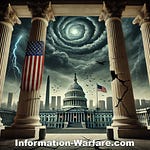Introduction
Hello, I’m HASE Fiero, editor of Information Warfare Magazine.
Today, we revisit one of the most pivotal transitions in modern geopolitics: how the United States, after emerging victorious in Cold War I, inadvertently set the stage for Cold War II. Through strategic missteps, unfulfilled assurances, and a lack of balance in its policies, the US ignited a renewed rivalry with global implications.
In this analysis, we explore the "Not One Inch Eastward" assurance, NATO’s expansion, and the calculated moves that defined the post-Cold War era and Cold War II. This journey will unravel how actions intended to secure peace instead fanned the flames of division, positioning the US on the brink of losing its dominance on the global stage. Let’s begin this thought-provoking journey into history, strategy, and the lessons we must learn to navigate a fragile global order.
The "Not One Inch Eastward" Promise and Its Aftermath
The Assurance to Gorbachev (1990)
As the Cold War was winding down, US Secretary of State James Baker, alongside other Western officials, reportedly assured Soviet leader Mikhail Gorbachev that NATO would not expand "one inch eastward" beyond Germany. These assurances were critical to securing Soviet agreement to German reunification and the withdrawal of Soviet forces from Eastern Europe.
However, no formal treaty codified this promise. This left room for interpretation and eventual disregard. While Gorbachev later acknowledged the informal nature of these assurances, the perception of betrayal became deeply ingrained in Russian political discourse.
NATO’s Expansion: A Broken Promise or Strategic Overreach?
1990s Expansion:
In the post-Cold War era, NATO incorporated former Eastern Bloc countries like Poland, Hungary, and the Czech Republic. For these nations, NATO membership was a guarantee of security against potential Russian aggression.
2004 and the Baltic States:
The inclusion of Estonia, Latvia, and Lithuania—former Soviet republics—was viewed by Moscow as a particularly provocative move.
Ukraine and Georgia (2008):
NATO’s Bucharest Summit declaration that these nations would eventually join the alliance was seen as crossing a red line for Russia, further intensifying animosity.
By expanding NATO eastward, the West arguably overplayed its hand, prioritizing immediate gains over long-term stability.
The Strategic Missteps of a "Unipolar Moment"
The Wolfowitz Doctrine
In 1992, the Defense Planning Guidance (commonly known as the Wolfowitz Doctrine) articulated a strategy for the US to maintain global dominance by preventing the rise of any rival power. While ambitious, this approach reflected a triumphalist mindset that overlooked the importance of balance in global affairs.
Middle East Distractions
The US expended significant resources on interventions in the Middle East, including:
The 2003 invasion of Iraq, based on false claims of weapons of mass destruction.
Regime change efforts in Libya and Syria, which destabilized the region and fostered anti-American sentiment.
These actions diverted attention and resources away from addressing Russia’s resurgence and the rising tensions in Eastern Europe.
Russia’s Resentment and Resurgence
Perception of Encirclement:
From Moscow’s perspective, NATO’s expansion, US missile defense systems in Europe, and Western support for "color revolutions" in post-Soviet states constituted an existential threat.
Economic and Energy Dimensions:
Ukraine, a key transit country for Russian natural gas, became a focal point of economic and geopolitical contention.
EU-backed efforts to reduce dependence on Russian energy amplified Moscow’s sense of encirclement.
Crimea and Eastern Ukraine (2014):
Russia’s annexation of Crimea and involvement in Eastern Ukraine reflected a calculated response to what Moscow perceived as Western overreach. These moves underscored its willingness to assert itself militarily and politically.
How the US Ignited Cold War II
Broken Promises and Strategic Overreach
By failing to honor the spirit of its 1990 assurances, the US undermined trust with Russia. NATO’s expansion and the framing of Russia as an eternal adversary reignited the very dynamics that the end of Cold War I sought to resolve.
Underestimating Russia
The West’s focus on the Middle East and its dismissive approach to Russia allowed Moscow and Putin to rebuild their cyber, military, and economic clout. This resurgence laid the groundwork for a new era of geopolitical conflict.
Russia’s information war extended into Super PACs, enabled anonymously through Citizens United, and became evident when Republican anti-Trumpers transitioned to MAGA loyalists.
Through state-sponsored entities like the Internet Research Agency and platforms such as RT and Sputnik, Russia deployed disinformation campaigns aimed at undermining democratic institutions, influencing elections, and sowing discord within Western societies.
The US on the Verge of Losing Cold War II
Eroding Alliances
NATO’s internal divisions over defense spending and strategic priorities have long been a source of weakness. Trump’s amplification of these issues and his inconsistent foreign policy further undermined alliance cohesion and created openings for adversaries like Russia.
Economic and Military Constraints
The US’s national debt and military overstretch limit its ability to project power effectively.
Russia and China’s growing partnership presents a formidable challenge to US hegemony.
Lessons from Cold War I: A Path Forward
Rebuilding Trust and Diplomacy
The US must acknowledge its role in creating the conditions for Cold War II and rebuild trust with adversaries and allies alike. This includes revisiting arms control agreements and fostering open dialogue with Russia.
Strategic Realignment
Prioritize balancing power rather than pursuing dominance. Address vulnerabilities in alliances and confront disinformation with coordinated strategies.
Conclusion
Cold War II was not inevitable. It was the result of strategic missteps, broken promises, and triumphalist policies that failed to prioritize stability. If the US continues on its current path, it risks losing the very global influence it sought to protect.
Acknowledging Russia’s grievances does not mean conceding to aggression. Instead, understanding the roots of their discontent can foster meaningful dialogue. The US can navigate these challenges without destroying its democratic principles or alliances. Stability and peace remain the ultimate goals.
For more thought-provoking analyses, visit InformationWarfare.com. Thank you.










